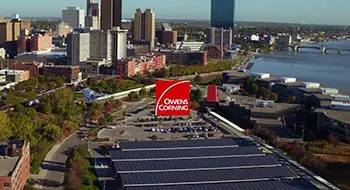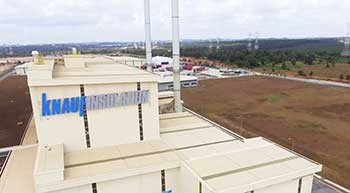When it comes to home insulation, Owens Corning and Knauf are two of the biggest names in the industry. Both companies offer a wide range of insulation products for thermal, acoustical, and even fire protection needs.
But when trying to decide which brand to choose for your next insulation project, there are some key differences to consider.
A Brief Comparison Table
| Feature | Owens Corning | Knauf |
| Main Materials | Fiberglass, mineral wool, foam boards | Fiberglass, mineral wool, foam boards |
| Popular Fiberglass Products | EcoTouch PINK, AttiCat blown-in | EcoBatt batts, InsulSafe blown-in |
| Popular Mineral Wool Products | Thermafiber | JetStream blown-in |
| Fire Resistance | Fiberglass melts at ~1000°F | Mineral wool is noncombustible to 2150°F |
| Mold Resistance | Effective mold inhibitors | Treatments resist mold for 60+ days |
| Noise Reduction | NRC 0.7-0.8 | NRC up to 1.05 |
| Cost | $$ | $$$ |
| Sustainability | High recycled content | High recycled content, low VOC binders |
| Warranties | Limited lifetime | Limited 10 years |
| Availability | Widely available | Widely available |
Owens Corning Insulation Overview

Founded in 1938, Owens Corning is an industry leader known for pink fiberglass insulation. Some of their most popular insulation products include:
- EcoTouch PINK Fiberglas Insulation: Their classic batt and roll insulation made from recycled glass. Available in various R-values.
- FOAMULAR Extruded Polystyrene (XPS) Rigid Foam Insulation: Rigid foam boards for exterior continuous insulation.
- Thermafiber Mineral Wool Insulation: Fire-resistant mineral wool for thermal and acoustical performance. Made partially from recycled materials.
Owens Corning focuses heavily on their sustainability efforts. Many of their insulation products contain recycled content and are recyclable themselves. They also have third-party certifications for indoor air quality.
Knauf Insulation Overview
Established in 1978, Knauf Insulation is also a leader in fiberglass, mineral wool, and other insulation materials. Some of their top products include:

- EcoBatt Fiberglass Insulation: Formaldehyde-free fiberglass batts and rolls made with ECOSE Technology.
- JetStream MINWOOL Insulation: Ultra-high density mineral wool for blowing insulation. Excellent for soundproofing.
- Extruded Polystyrene (XPS) Rigid Foam Boards: XPS continuous insulation for basements, exterior walls, etc.
Knauf places a big emphasis on their patented binder technologies like ECOSE that enhance sustainability without compromising performance. Their products also have various green certifications.
Now that we’ve covered the basics on each brand, let’s compare some key factors to consider when choosing insulation:
Owens Corning And Knauf: In-Depth Comparison Of Key Features
- Soundproofing Ability
For noise reduction, mineral wool outperforms fiberglass. Knauf’s JetStream MINWOOL blown-in insulation has an NRC (Noise Reduction Coefficient) rating up to 1.05, absorbing more sound. Fiberglass batt insulation from Owens Corning has an NRC closer to 0.7-0.8. For apartments and condos, mineral wool can make a big difference in blocking exterior noise or noises between units.
- Insulation Ratings
The main measurement of an insulation’s thermal performance is its R-value. The higher the R-value, the better it insulates. Owens Corning and Knauf both offer a wide range of products with varying R-values. Thickness plays a big role, with thicker insulation providing higher insulation ratings. For maximum efficiency, choose the highest R-value insulation that fits within your budget and space constraints.
- Cost Comparison
In general, fiberglass insulation tends to be more budget friendly compared to mineral wool. Owens Corning EcoTouch Fiberglas batt insulation runs around $0.70-1.10 per square foot depending on thickness. Comparable Knauf EcoBatt fiberglass batts cost $1.00-1.60 per square foot. For blown-in insulation, Owens Corning ATTI-KO loosefill insulation is about $0.85-1.35 per square foot compared to $1.25-2.00 per square foot for Knauf JetStream mineral wool. Foam boards can run $1.00-1.50 per square foot from either brand.
- Environmental Impact
Both manufacturers prioritize sustainability and recycled content in their insulation materials. Around 40% of Owens Corning fiberglass insulation is made from recycled glass. Knauf also uses a high percentage of recycled materials, like recycled slag for their mineral wool. If low VOC emissions are a priority, Knauf insulation products with ECOSE technology have UL Environment certifications for emissions testing. Owens Corning insulation meets GREENGUARD standards. Ultimately, both brands offer greener options compared to legacy materials like asbestos insulation.
- Fire Resistance Properties
For fire safety, mineral wool has a clear advantage. Materials like Knauf Insultech MINWOOL Insulation are rated noncombustible to ASTM E136 and can withstand temperatures up to 2150°F. Fiberglass insulation melts around 1000°F. Building codes often require noncombustible mineral wool in fire-rated assemblies. If fire safety is a top concern, choose a mineral wool product over traditional fiberglass.
- Mold Resistance
Mold growth is a common problem in poorly insulated buildings. To inhibit mold, both manufacturers treat their insulation with antimicrobial additives. Independent testing shows that Knauf insulation resists mold growth for at least 60 days. Owens Corning also claims effective mold resistance, but doesn’t disclose specific timelines. For optimal mold inhibition, combine antimicrobial insulation with proper moisture control and ventilation.
- Ease of Installation
Most Owens Corning and Knauf insulation products are designed for simple DIY installation. Their batts and rolls allow for a friction fit between studs and joists. Blown-in insulation requires special blowing equipment but can reach places that batts can’t. Rigid foam boards glue into place or use mechanical fasteners. Overall, neither brand has a significant advantage in installation ease. Just follow each product’s recommended installation instructions.
- Warranties
It’s reassuring to have strong product warranties when investing in insulation. For their fiberglass batts and blown-in insulation, Owens Corning offers a limited lifetime warranty as long as the product is installed properly per guidelines. Knauf’s comparable fiberglass and mineral wool insulation products come with a limited 10-year warranty. For added coverage, professional installation by a certified contractor can extend insulation warranties.
- Availability
As two of the largest U.S. insulation manufacturers, both Owens Corning and Knauf products are widely available at major home improvement stores like Home Depot and Lowes. They can also be purchased through individual distributors or local insulation contractors. Online retail availability is limited due to the nature of insulation shipping, so brick-and-mortar stores are ideal. If you have difficulty finding a specific product locally, check with the manufacturer.
Also watch this about Knauf Insulation!
Frequently Asked Questions (FAQ)
Yes, Knauf manufactures high quality insulation products including fiberglass, mineral wool, and rigid foam. Their materials feature excellent thermal performance along with soundproofing and fire resistance capabilities. Knauf insulation incorporates recycled materials and is designed for sustainability.
Owens Corning and Knauf are two of the top insulation brands, but several factors determine the best insulation for your specific project. The optimal insulation depends on your budget, performance needs, eco-preferences, and installation location.
Compare R-values, soundproofing, fire ratings, and other features when selecting insulation materials.
For attics, blown-in cellulose or fiberglass insulation offers benefits over batts. The loosefill insulation can fit easily around wiring, vents, and other obstructions. Cellulose has higher R-values per inch but fiberglass is more affordable. Look for blown-in insulation with a minimum R-value of R-38 for attics in colder climates.
Insulating properties mainly come down to the R-value, so the type of insulation with the highest possible R-value will provide the best thermal insulation.
Foam boards like polyisocyanurate and XPS rigid foam offer R-values around R-5 to R-7 per inch, giving excellent insulating value for the thickness. Thicker batts and blown-in insulation also achieve high R-values.
Also Read: Is Johns Manville Better Than Owens Corning Insulation?
Conclusion
For fiberglass: Owens Corning EcoTouch insulation or Knauf EcoBatt insulation offer similar thermal performance and cost savings. EcoTouch contains more recycled glass while EcoBatt uses a formaldehyde-free binder for indoor air quality.
For mineral wool: Knauf JetStream blows in easily and offers maximum noise reduction. Owens Corning Thermafiber also absorbs sound well and is more affordable.
For rigid foam: Owens Corning FOAMULAR extruded polystyrene (XPS) stands out for its higher R-value per inch than standard XPS. Knauf also makes quality polyiso and XPS boards.
For blown-in: Owens Corning and Knauf both have cellulose, fiberglass, and mineral wool options depending on your needs. Compare soundproofing, fire resistance, and cost.
No matter which brand you choose, following proper installation guidelines is vital to get the rated R-value and performance. Investing in professional insulation can also provide added peace of mind. Contact a qualified local contractor for recommendations and product availability in your area.
With both Owens Corning and Knauf insulation, you can be confident you’re getting a highly effective insulation product backed by industry leaders.
